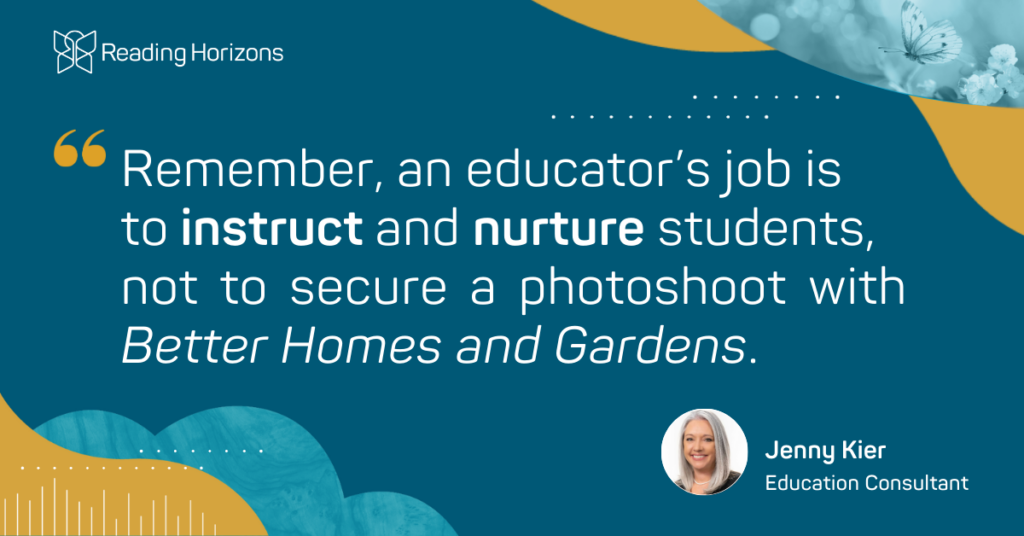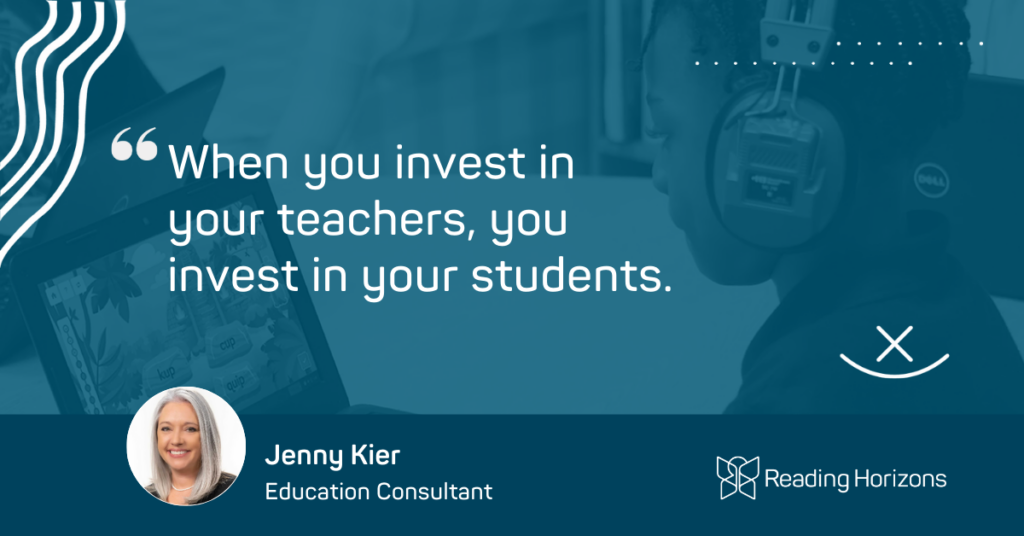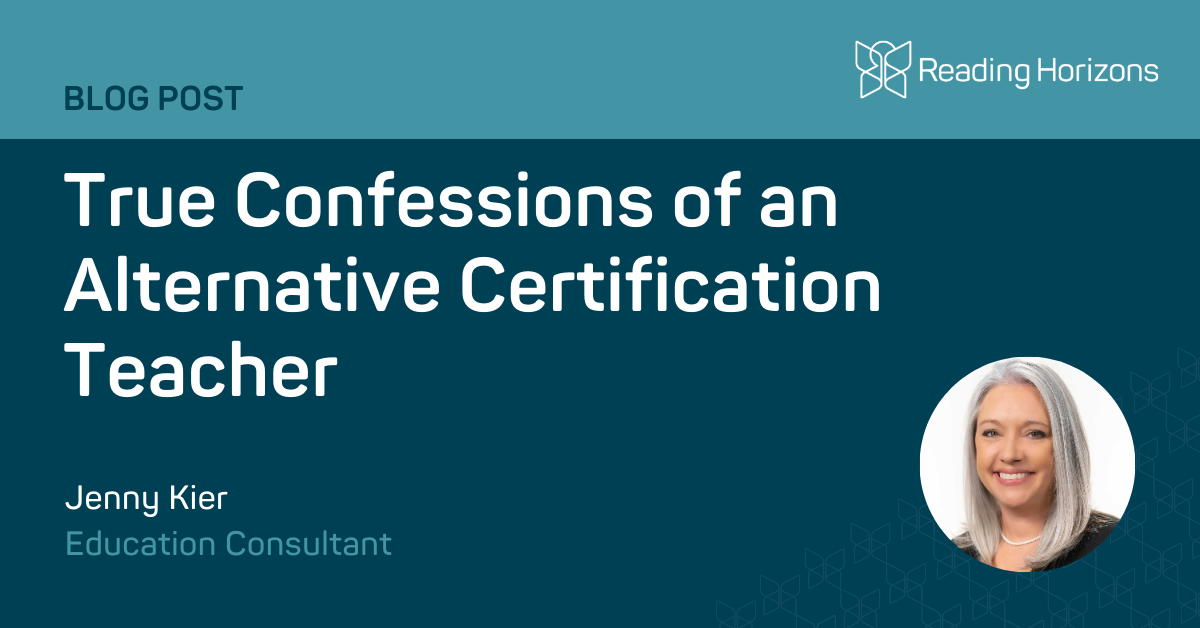
BY JENNY KIER, EDUCATION CONSULTANT
Would you want someone with a Psychology degree working on your car engine? Someone with an Economics degree cleaning your teeth? Someone with a Maritime Administration degree (or any non-education degree) teaching your children how to read?!
Believe it or not—and please don’t panic—this last one happens in classrooms across America every day.
According to Next Gen Personal Finance, only 46 percent of college graduates currently work in their field of study. When I decided that using my Bachelor of Science in Maritime Administration wasn’t for me (a story for another time), I became an alternative-certified, aka alt-cert, teacher in Texas. Although I left the classroom after 13 years, my heart still lives in K–12 classrooms across America.
Alternative Certification is the First Step
After alt-cert teachers complete their programs, pass the required exams, and secure jobs, their learning journey continues. They need strong and supportive leaders to help them bridge the gap between theory and practice in the classroom.
Let’s be honest: I felt a lot of uncertainty when I first entered the classroom. Here, I’ll share my biggest knowledge gaps—and how I overcame them—so newly minted alt-cert teachers in your school or district can reach their greatest potential.
I Didn’t Understand the School Ecosystem
The day I arrived on campus, the assistant principal took me to “my hallway,” which consisted of gray and blue tiles, three restrooms, and ten classrooms. I smelled fresh paint and saw the newly waxed floors. It all added to the dopamine coursing through my brain. I met the teachers who were around and finally landed in my very own fifth-grade classroom!
The rest of the day (and the next two weeks) was a blur of teachers, titles, and responsibilities. I craved a time when I would know everyone and their duties just like the teachers who’d been there for twenty years. I dreamed of understanding the teacher talk, jargon, and inside jokes that soared over my head.
Before alt-cert teachers arrive on campus, it’s critical to plan a structured onboarding. School hierarchies, roles, and responsibilities will likely be foreign to them—not to mention the acronyms! And does educational jargon ever end? Spoiler alert: It doesn’t.
However, you can alleviate the confusion by organizing a meet and greet with key faculty members, giving a school tour, and sharing a cheat sheet detailing who to contact for various questions. Consider including the following:
- Faculty member headshots with titles and job descriptions
- A school map
- Common terminology regarding methodologies
- Frequently used acronyms
Remember to introduce the custodial and maintenance teams; they are some of the most critical team players and can be extremely helpful for new teachers!
I Needed a Buddy
Alt-cert teachers need buddies. A buddy can lessen leaders’ burdens by assisting individual educators as they strive to prepare an entire school for the year ahead.
However, this doesn’t mean assigning mentors willy-nilly. My mentor was a top-tier teacher but an ineffective mentor (she once yelled at me, and that was the extent of our interaction). It’s important to consider that great teachers of students are not necessarily great teachers of adults.
Consider personality types and a mentor’s willingness to go the extra mile. Were they a previous alt-cert teacher eager to pay it forward to a newbie? Do they want to move into a leadership role and see mentorship as a first step? A great mentor has a growth mindset and sees student outcomes as a shared goal. Plus, they guide with their actions—not only their words.
Be sure the mentor understands expectations clearly. Here’s where a checklist comes in handy! Ensure the checklist includes early planning tasks and milestones throughout the academic year (e.g., spring testing season and end-of-year responsibilities). Instead of a “sell by” date, include a “know by” date!
I Had Unrealistic Ideals for the Classroom

Here’s a formula we didn’t learn in algebra: The most beautifully decorated classroom is not greater than or equal to student mastery.
When I first arrived in my classroom, I was thoroughly focused on having the perfect Pinterest setup. The importance of using wall space for reference posters or student learning objectives wasn’t even on my radar.
A mentor or grade-level teaching partner can help new teachers know what to focus on:
- Safety
- Logistics
- Student learning
- Student independence
Decor should not impede the pathway to safety, nor should it be so overwhelmingly stimulating, covering every square inch of walls, that students can’t focus. Remember, an educator’s job is to instruct and nurture students, not to secure a photoshoot with Better Homes and Gardens.
I Didn’t Know How to Plan a Lesson
My most memorable first-year moment was slowly walking into my principal’s office, tail between my legs, to tell her, “I don’t know how to write a lesson plan.” She was kind and said, “Girl, no first-year teachers do! Come in and sit down.”
Despite her guidance, I struggled to communicate key instruction pieces to students.
“How do I ensure what I’m saying aligns with the standards? How do I make sure I’m guiding them through practice correctly? How? How? How?!”
Then, one day, the alt-cert fairy godmother dropped by and gifted our district with a turn-key, science-backed, proven effective, and scripted curriculum! I didn’t know it then, but having a script to follow helped me grow by leaps and bounds. It’s like baking a sugar cookie: follow the recipe until you know it by heart. Then, when you’re ready, put your own spin on it.
As an administrator, you want all educators to teach consistently, accurately, and effectively. With scripted lessons, all the alt-certs need to do is read, relay the message, and follow along! Your—and their—reduced anxiety is simply a bonus.
I Realized How Much I Still Had to Learn

“Here are your instructional materials: manuals, posters, visuals, workbooks, manipulatives, and software. Go teach!”
Finally, and I can’t light this sign up brightly enough, invest in your alt-cert teachers! Spending a district’s big bucks on curriculum and then skimping on the professional learning is like ordering a dresser from IKEA and disregarding the assembly instructions.
Each year, I would receive a stack of new books about reading, writing, and math. The associated professional learning covered “what” I was teaching but the “how” is what I needed. I needed to know how to educate a classroom of 27 nine-year-olds effectively! Not all professional learning is created equally; I learned that the hard way.
Effective professional learning and coaching can be the difference between student success and a failed implementation. Every educator, especially those new to teaching, should have structured professional learning opportunities at the beginning and throughout the year. Yes, it can get expensive, but when you invest in your teachers, you invest in your students.
Remember: alt-cert teachers don’t know what they don’t know. Take advantage of on-site experts and have them present once a month during Professional Learning Communities (PLCs) or conference periods. Have the special education teacher discuss IEPs, what they are, and how to follow them. Ask your behavior intervention coordinator to explain de-escalation and communication tips and techniques. Getting your on-staff experts involved in onboarding won’t cost you a dime!
Don’t Just Survive—Thrive!
Even with an alternative certification, transitioning to the classroom is neither fast nor easy—but it doesn’t have to be an episode of Survivor. While new teachers may sometimes feel like they’re just trying to survive until the bell rings, if you invest in them from the beginning, you’ll reap the rewards through student growth, understanding, and mastery!
If you want to hear more about my alt-cert journey—the good, the bad, and the ugly—watch our webinar or read the guide!
Common Acronyms in the K–12 School Setting:
- 504 Plan – Section 504 Plan refers to plans developed to ensure that a child who has a disability identified under the law and is attending an elementary or secondary educational institution receives accommodations that will ensure their academic success and access to the learning environment.
- AP – Advanced Placement: A program that offers college-level curricula and exams to high school students, allowing them to potentially earn college credit and advanced placement in college courses.
- ELA – English Language Arts: An ELA block of time typically encompasses reading, writing, speaking, listening, and language skills in English.
- ELL/ESL/MLL/EB – English Language Learner/English as a Second Language/Multilingual Learners/Emerging Bilingual: Terms for students who are learning English in addition to their native language.
- IE – Inclusive Education: An approach where students with special needs are educated alongside their non-disabled peers.
- IEP – Individualized Education Program: A plan tailored to meet the unique educational needs of a student receiving special education services.
- MTSS – Multi-Tiered System of Supports: A strategy to give targeted support to struggling students.
- PBIS – Positive Behavioral Interventions and Supports: A framework to promote positive behavior in schools.
- PLC – Professional Learning Community: A group of educators who collaborate regularly to improve teaching practices and student outcomes.
- RTI – Response to Intervention: A method of providing early, systematic help to striving students.
- SLO – Student Learning Objective: A specific, measurable goal a teacher sets for student learning over a set period.
- SPED – Special Education: Instruction designed to meet the unique needs of a child with a disability.
- SST – Student Support Team: A collaborative group of educators and specialists who identify and address the academic, behavioral, and social-emotional needs of students through targeted support and interventions.

